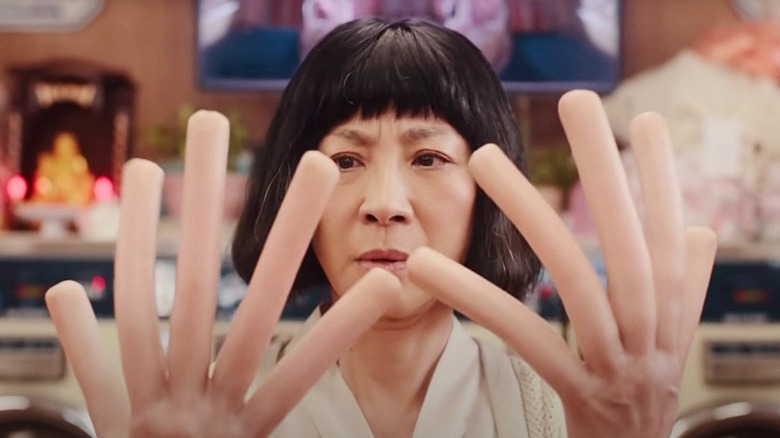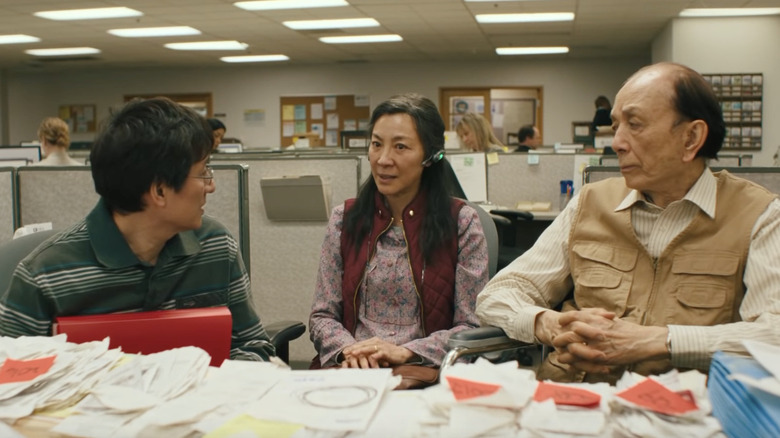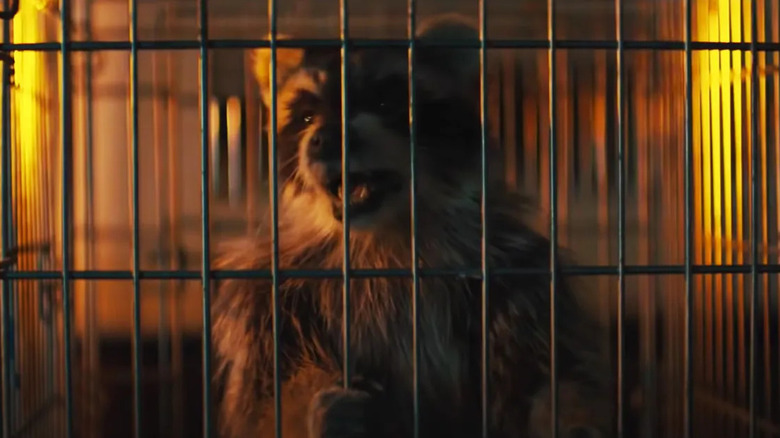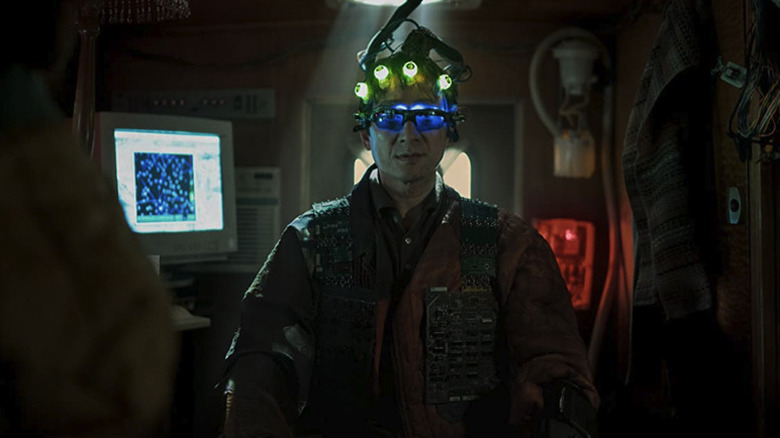The Everything Everywhere All At Once Sound Team On Enhancing The Movie's Most Spoilery Moments [Interview]
Sometimes actors, filmmakers, and crew members will say that the experience of working together on a movie was "like one big family." In the case of "Everything Everywhere All at Once," it's easy to believe. From the composers to the stunt coordinator to the costume designer to the sound department, everyone describes the process with love. It's fitting, given what the story reveals itself to be about in its final, moving action sequence.
The sound team behind Daniels' "Everything Everywhere all at Once" had a tall order in creating varied universes and expressing chaos, lunacy, and peace. This is a movie where every moment is a moment, too. Every image and sound is consequential. Recently, we spoke with sound designer/sound effects editor Andrew Twite, re-recording mixer Alexandra Fehrman, re-recording mixer/sound supervisor Brent Kiser, and ADR Supervisor Julie Diaz about bringing the sound of "Everything Everywhere All at Once" to life.
Warning: Major spoilers below.
"Add some hot dog fingers and you got the cake made"
Let's start with the "2001: A Space Odyssey" sequence. What work did that sequence involve?
Kiser: Well, first off, shout out to Jason Kizvade, the production designer. He's the one that suggested this YouTube video. I can't remember the name, but it's kids from an elementary school, junior high, high school band playing that song. And so he was like, "This is the perfect song." I don't think we could get the rights because it was a school that played it or whatnot. So that bad trumpet is actually [co-director] Dan Kwan playing it. It's the big vocal arrangement of the monkeys while all of us are also screaming as monkeys together.
Diaz: A group recording. I had a group come in and do it. They had no concept of the movie. And I was like, "I need you guys to just sound like monkeys fighting each other and screaming."
Kiser: And then obviously just add some hot dog fingers and you got the cake made.
Fehrman: My experience was shock at first. I thought, "Oh my God." Well, that's how it happened. It was a great little interlude there, but it was wild on the stage because, of course, we wanted to make it sound all around us. The sausage fingers were icing on that.
Were there a lot of surreal moments like that working on this movie?
Fehrman: I mean, something that was really surreal was the verse. I really loved the verse when we would do the quick cuts through the verse, the universes versions. I felt that was something really cool for sound design, because it was able to transport you to multiple different places in such a quick sequence. Everything sounded very authentic and you felt like you were there, just like Andrew designed it to be. Even if you were just there for a second, there's something distinctive that happened in every place, so that you felt like you were really jumping through your time.
Andrew, how did you get that sound for the jumping between universes?
Twite: Well, first, we got some early cuts. Actually, we were just asked by Daniels and the editor, Paul [Rogers], because they were actively trying to add temp sounds into place as they were editing. And that really actually helped them tie scenes together. At first it was just like, "Hey, can you try our green jumps, our positive jumps that ... when they're going to be going to the right place to acquire that correct skill, can we try some versions of that? Can we try some jump fails where she goes back to do her taxes?" So we took it real, real far. I did a ton of mini-work.
I recorded all sorts of random things and processed them, just to try and see what we could do. We even talked about bending time. That was something we talked about with Kwan. We went really extreme sci-fi and ultimately came back around to a simplicity, because it's not so much about the tech that makes these jumps work. It's about this fluidity and story. Ultimately, we landed back on a very simple process of tech that just totally seems to work. There's something rudimentary about it. I think the sound reflects that at the end of it.
When I talked to Brent about the movie, he said how even the simplest of sounds, like the whooshes and the wind, were complicated. What else was deceptively challenging about those fight scenes?
Fehrman: I think the fight happens inside of the office, where it's a very surrealistic fight and the music cue is driving.
Twite: The three-person fight.
Fehrman: Yeah. I thought that fight was deceptively challenging because Daniels really wanted it to have a unique look and feel. With the sound design, it wasn't all literal. It was very much to be felt. We have the impact and the movement and everything, but not necessarily the literal sounds of the punching and what you would typically hear in a fight like that.
Twite: More impact. I mean, there are whooshes and swishes in there, but not as kung fu [as], like, the fanny pack scene fight. When we have them fighting with the pipes, we're leaning more on the weapons and the sounds they make moving through the air.
Kiser: This was very much like "Crouching Tiger, Hidden Dragon." More of the slow feel of the fight movements, the actual poetry of it.
Twite: This fight, she's trying to fight off these two guys, but also, it's knocking her in and out of different universes. So we're also leaning on the glass. We're leaning on the radio, because their frequencies are shifting. She's trying to keep her mind intact while balancing these universes at the same time. It's a heady concept and everything's really rapid fire, but creating the definition and not cluttering it up too much so you're not being pulled out of that moment, either.
One thing I realized early on, when I started to just look at the movie, I was like, "Okay, we have this fight scene. We have this fight scene." I quickly realized that, "Man, these things all flow together and they are born out of each other as it goes." So being very conscious, trying to develop a vibe without it being jarring when you move on, if that makes sense.
"I have a minute of a burp track from him"
There's a complexity to these universes and a lot of heightened sounds and elements, but when was simplicity and reality best for the sound?
Twite: We were given great guidance by the Daniels for this. We were able to have conversations with them every step of the way about how something should feel at any given moment. They were great about giving us references to lean on. Again, they gave us a wonderful roadmap in their temp, to understand the feel and the flow that they wanted. So that was a big deal.
Kiser: I think these were the moments where during the initial sequences, we're finding out about the multiverse where you have Wayman, often the side mirror, and we're going back and forth. That was a really important part for Daniels to feel and establish what needs to be grounded in a world of nonsense in the way of, like, "We don't know this to exist in this multiverse, but it has to feel grounded." So these effects need to be grounded, then we can go past there. So it was establishing this as a norm, and then allowing it to go crazy. So that's why the movie's so great about its slow burn on how ridiculous it becomes.
Fehrman: Everything's pulsing up. Everything in the film is growing emotion.
Twite: The word was swell. He's like, "Can we swell in?" Swell in. It is all over the place.
One of our most grounded moments is the rocks in that canyon. That is such a quiet, calming moment, and you feel that environment so much. It wasn't just a flatbed. We had swells, we had chimes. There was a beauty to support this profound conversation that's happening between mother and daughter, without being in the way, but suddenly giving the audience a chance to breathe, but to just really appreciate this moment. I think that scene there's just something very, very beautiful about it.
Julie, how was collaborating with the Daniels on ADR? What were some of your conversations about when it comes to what they needed there?
Diaz: I worked really hard and closely with the Daniels just to get additional things for additional dialogue recordings. I would have the cues that we wanted and they wanted, and then during the sessions, they're constantly evolving. They're like, "Actually, do it this way. Actually, can you sing it this way?" They would have all these great ideas on the fly. And then when I'd sit down with them to edit it in, they were like, "Actually, we don't like the singing here. Let's just go back to the original." They were thinking, "How do we make this bigger so that we can have it?"
Then when it came down to the edit, they would pick and choose. I think some scenes turned out amazing with a lot of these gems we got in the recording. At one point towards the end, we had the K-pop singer. In Stephanie Hsu's recording, we got her to sing and she's great. She's incredible. We have all these backup things to what she was saying. She's like, "Have a nice life." It's in the background.
I still have hours of all these recordings. And just figuring out, "Okay, does this actually serve this scene? And what adds to it? What doesn't?" I thought it was a really cool process to sit with them, and I was very honored.
What were some other major moments that required ADR?
Diaz: There was so much ADR in this movie. A lot of our ADR stuff was the Daniels really being like, "I don't like how this was delivered. Let's just get it again." It wasn't technical and it wasn't super bad recordings or anything like that. It was mostly just, again, how do we elevate these scenes and elevate the emotional story points to make this better? In the recording I did with Michelle, she was in Paris. And this was all during the pandemic. It was all on Zoom and it was 4:00 AM our time. I would do it for her in a heartbeat again. We had maybe 20 lines for her. These actors, and especially even James Hong, they're used to coming and redubbing the entire movie.
Kiser: And Shaw Brothers right there.
Diaz: Exactly, yeah. We knocked out the 20 and it was a lot of breath takes and a couple rereads of certain things. She's like, "So this is it? You don't need anything else?" I was like, "No. This is great." So she was just like, "All right, great." And then she was talking to Daniel Kwan and was like, "Let me see your kid." She wanted to see his baby.
Even James Hong, who is a legendary voice actor, came in and we just mostly needed grunts and struggle passes for when he is fighting. He was just like, "Well, I can do all these things for you." I have a minute of a burp track from him. Because he was like, "I'm just going to do this for you." And we're like, "We don't even need this, but thank you."
It was so cool to just work with all these legends and see even their take. Also, English, Cantonese, and Mandarin, having these three languages. I didn't know a lot of what any of them were saying, especially when I had a Mandarin, Cantonese, and English group come in. That was an experience in and of itself. I worked very closely with a lot of our editors who translated it a lot for me.
Kiser: The assistant editors.
Diaz: Yeah, the assistant editors. Zoe and all them. That was really cool to just have more of a collaboration on all aspects of it all. So there's not a lot of technique. It's mostly just like, "Hey guys, this is all I need. It's better for you." And then I also learned some other languages at the same time.
"One of my favorite characters, because how could it not be?"
Alexandra, when it comes to Raccoonie, how'd you either want to play up or down the sounds for that joke?
Fehrman: Oh my goodness. One of my favorite characters, because how could it not be? We really had to work hard in making sure that the jokes were highlighted and making sure Michelle's character, when Evelyn bumps into the pots and pans and stuff, that was felt by us as the audience, but not loud enough that Racacoonie could know that she was there. So that was really fun. And then of course, her guiding him and all of that. That was pretty much my experience there. Most of the fun there was in the voice, I would say.
Julie, how much did you work with Randy Newman there?
Diaz: Oh man, that was I think one of the highlights of my career, if not the high of my career. It was such an amazing experience and he's such a pro and a hero of my childhood. I actually had Ryan of Son Lux on a Zoom with us too, because he was singing, too. It turned into this cool ADR/music recording session. Randy didn't know what the hell was going on, which was also funny, because he was just like, "I'm this raccoon." And then he was giving us all these funny, cool wild lines that actually made it into the movie here and there, especially at the end when Michelle's sitting in the tax office after everything has happened. But that was such an incredible experience. He's amazing.
Kiser: Also, get ready for the full length track coming out on the soundtrack from Son Lux, because Ryan and them actually made a full I think three or four minute version of his song.
Diaz: It's great.
Julie, was any ADR needed for the parking lot scene in the third act?
Diaz: No. The boys absolutely refused to do ADR in that, and I was very much in agreement. Our dialogue editor, Danny Raphael, who was incredible and amazing, cleaned that up spectacularly. We did not want to do ADR in that at all. The emotional impact of it was captured on that day on set, and nobody wanted to mess with it. There was none in that section, and I'm really happy that there wasn't, because it was already flawlessly executed.
Twite: That's another scene that brings us right back to reality, like your previous question. It's like, you're suddenly back. All the rest of that, we know it exists, but we're back. We are in that moment. It's incredibly important. It's your sense of resolution. So we didn't want the [background ambiances] to get in the way. They're definitely in that environment. You can feel the city a bit, but we didn't want anything to take away from this powerful interaction that was happening.
I've heard that some great actors aren't great at ADR. In your experience, what's the difference between someone comfortable with ADR and someone who's not?
Diaz: I don't think it's really a thing of whether they're great or not. It's really one of the things is if they want to or not, is what I'm noticing. I did a movie where the actor did not want to do ADR and it was very apparent, but it's one of the things where it's like, they don't want to feel like they didn't do a good job at their performance. ADR is never really like, "Oh, you sucked or anything." It's like, "Hey, let's just make this better." Or the director rewrote the line or the evolution of it all.
There's not really a distinction other than just whether the actor truly wants to or not. I was so thankful and grateful and lucky on this project that everybody was down. Everybody wanted to be there. Everybody loved the Daniels, and the Daniels created such an environment that to ask to bring in actors even for maybe five or six lines, everybody's like, "Yes, what can I do for you?" They brought their A-game every single time. I was very thankful for this experience, because it's not always like that. A lot of actors just don't want to, and that's what we have to deal with sometimes.
Kiser: These guys were such pros.
Diaz: "Hey, can you do this differently or whatever?" I never was really like, "Let me get another one for safety." It was like, "All right. We got two and they're great. That's all I need. There's no safeties. I don't need it." Everybody was just pros and they wanted to do it and they wanted to be a part, even on certain things that most actors don't really want to do.
"Make it resonate and in your chest"
Alexandra, what conversations did you have with Daniels about when Evelyn realizes love is the answer, when she recognizes the strength in that? How'd you want to help convey that?
Fehrman: When there's this beautiful, glowing red visual, I was working with Kwan about how to approach that, sound-wise. We had a lot of sound design in there, and I liked it all. I was attached to it. He kept having me thin it out and make it a little bit less focused. Make it a little bit more felt, make it lower, make it resonate and in your chest. I think that ended up being a really powerful moment, and it makes me cry every time I see it.
Twite: I can actually second that because I definitely cried, too. It is also a moment that Rafiq from Son Lux spent so much time on that music cue. We were talking after the screening about moments that hit us. He was like, "Which one was it for you?" And I said the moment that Alex just described, and he was like, "Oh my God. I had to do so many different versions of that. That was one of the hardest cues that I had to deal with in that entire movie." It meant so much to him that it had that kind of impact even on me who had worked on the film. So that's a killer moment.
How'd you approach peace and quiet towards the very? Obviously, it's very important for Evelyn's arc.
Twite: Oh man.
Kiser: It's the atonement part. This is where Evelyn's atoning for all of the craziness she did before in the existential crisis and "f*** everybody" moment. So this is where Daniels wanted us to really help solidify she's healing her mistakes and you can come back.
Twite: It becomes a very playful moment after that for sound design, as she starts to work her way up the stairs. When she's like, "I'm beginning to fight like you." It's this beautiful moment of like, "I can solve my problems with kindness. In a world of other disarray and disorder, kindness can do so, so much." It's a powerful message. As she starts to work her way up the stairs, she shoots out the googly eyes, and you have this great moment from James Hong. This was a very, very deliberate sound design moment. Kwan and I discussed, "Okay, right before she grabs them, she's initiating this effect, that's going to change everything for the better in a sense."
So these angry people who are about to fight her, they suddenly fall in love and they get married. She fixes this dude's back, which I love the sound moment for that. The grenade turning into the spray bottle, it's all spinning a positive out of a negative. From that, there's a lot sound-wise going on, but there's a simplicity to it all and there's a beauty and almost a dance to it. It's one of my favorite parts of the movie, to be honest.
Any major stones we've left unturned? Any moments you want to highlight before the end?
Kiser: After talking about all of these things, I think one of the moments that we haven't talked about enough –
Diaz: When she realizes she has all these cool powers?
Kiser: Yeah, yeah, yeah. Really, how Andrew and Julie, through ADR, through enhancing performances, were able to really help Waymond, really show the duality of his character, because he's the one that really is playing four different people throughout this film. Evelyn's in different multiverses, but it's still the same Evelyn. Waymond is a different character, and I think it's great how these guys were able to help make that happen.
Twite: There are a couple themes that we leaned on heavily throughout. I love pointing out the radio, the frequency sweeps that really helps define Jobu's nature and all these multiverses and her control over it all, to just seamlessly move around. They were also our guides in and out of scenes. These glass elements were really, really big themes. We were able to use them not just as storytelling devices, but also to guide us in and out of scenes. Those are the kind of things that I feel like really glued our sound design together. They had different textures. We could highlight moments that stuck through the music. These were elements that people can relate to.
You're hearing them on a subconscious level and you know why they're there. They're not just there for fun. They're not just there to be quirky. They're definitely character defining elements. At first, it took me a second as I was cutting them to understand the strength that they brought to this, but these were all things that we talked about before we heavily got in the editing. Man, they just became such a big part of this movie.
I will say from the dialogue side, from the sound effects and design side, there's so much intention in there. There's a lot going on — there's so much specific intention with every little thing that we did. Also, trying to work with and stay out of the way of the music at times, because that score is such a big part of the flow and momentum of this film. We are able to work together so well to create this absurd, crazy story world.
Fehrman: I just want to add real quick before I go that I was really honored to be a part of this team. It was definitely a family. Working on Andrew's tracks was amazing. Working with Brett and Julie was life changing, and I hope to work with them again.
Kiser: There's a big room of badasses just being badasses.
"Everything Everywhere All at Once" is now playing in theaters.




